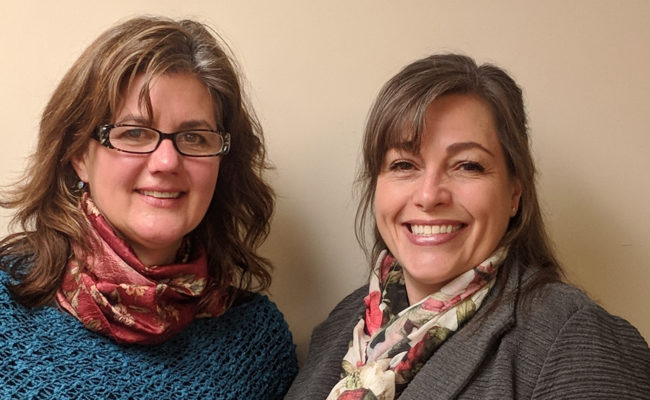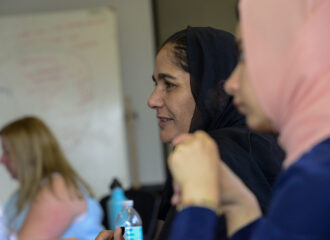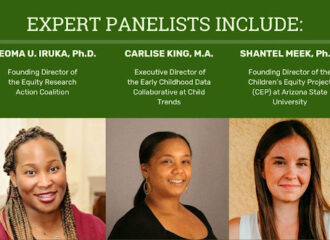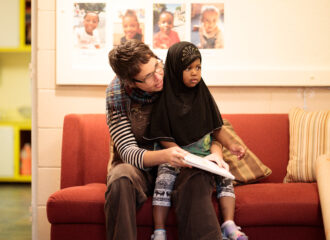
Have you ever wondered what Early Multi Tiered Systems of Support, or EMTSS is? This blog is all about how the Orange East Supervisory Union is working to implement Early MTSS, the successes and challenges, as well as hopes for the future, through an interview with practice-based coach, Jill Koppers, and the Early Education Services Coordinator, Marla Ianello.
Tell me a little bit about who you are and where you work
Jill: I am Jill Koppers and I work as an Early Childhood Special Educator and Early Multi Tierd Systems of Support Practice Based Coach through Orange East Supervisory Union (OESU) and this is my second year in that role
Marla: I’m Marla Ianello I am the Early Education Services Coordinator at Orange East Supervisory Union.
Can you tell me what Early Multi Tiered Systems of Support is in a way that anyone can understand?
M: Early Multi Tiered Systems of Support is a framework that holds 143 best practices that support the social and emotional development skill and competence of young children. Young children, you have to remember, means up through grade three, age 8.
How did you become interested in Early MTSS?
M: OESU had a pilot site in the district, Caring Community Preschool, which received a grant, a practice-based coach, and a trainer. They were doing this work and assumed that I knew about it and would ask me questions about it but I had no idea. This was three years ago.
Caring Community Preschool needed a systems coach and I have a background in organizational development. I said ‘I can be a systems coach, I know how to do board development’. So I became a systems coach. Then the practice-based coach had to move on. I haven’t been in the classroom in many years so I would be a lousy practice-based coach. Jill, on the other hand, has seen hundreds of classrooms and so many practices I just knew she’d be able to observe a teacher and immediately have suggestions and supportive resources whereas I would be a bit more lost in that.
During all of this I started to go to all of the free trainings around the state and I spent about a year and a half completely confused. I had no idea what Early MTSS was. I thought if I can’t get this then no one can. At Caring Community, which is an excellent program, they are super willing to learn and grow, they are diligent and really good teachers and they said they just don’t get it. They felt, “We are going to get trained, and coached, and there are all of the assessments, but what is all of this?”
I spent a lot of time trying to understand Early MTSS then created a way to share it with others. It became a challenge of taking what was hard to understand and making it more understandable. As I was making it more understandable and pulling the pieces together I saw the real value in not just implementing it in a couple places. I figured if we are going to do this we might as well do it across the entire SU. We also had to make sure that the change practices weren’t giving programs another ‘to do’, but instead acknowledged that teachers have these practices in place and all we were doing is putting it in a framework, so that we can start to find the gaps in your practices, like swiss cheese.
J: It’s a program I can really agree with: when they say “best practices”, its true. It’s an approach that looks at your way of thinking and helps you frame things. One of the skills we work on is reframing a negative thought. For example, we think about a student’s behavior, reflect on it, and think about where this child is coming from, what their needs are and what they are communicating through this behavior.
M: Even using a student’s name and making eye contact, that’s not a natural behavior for some teachers, and if they can habituate that, the kids are being seen and heard. Now they are less likely to engage in behaviors for attention because they’re getting attention in other ways.
J: And it gives language to teachers for things like relationships. Teachers have relationships with the children but now we can actually talk about what that looks like. For example, making eye contact and how many positives a child receives in the day and stuff like that.
What does an Early MTSS classroom look like and how would you know you were in one?
J: I think it depends on what phase you’re in.
M: This is a complicated question and here’s why. There’s no one look in an Early MTSS classroom. They’re going to have a visual schedule, so that would be a difference. The environment would be set up to not have big open spaces unless they were intentional. Caring Community has an intentional running space because they know that some of the kids have a need for running so instead of saying ‘there’s no running inside’, ‘we walk’, or ‘walking feet please’ they say ‘if your feet need to run remember that’s the space’.
J: I think it’s the intentional teaching of whatever we want to see in a classroom. If teachers are working on problem-solving then we will see books about problem solving, problem solving cards available for students, teacher’s guiding conversations in problem solving, or you might even see a talking table in the room for the children to go to and work out a problem. So what does it look like? It looks like a room that’s meeting the current needs of the individuals in the class and the class as a whole. This is where the framework and the toolbox come in because we are plucking what is needed to make it work with intentionality, settling in for the long term.
What is implementation like in Orange East Supervisory Union?
M: We have programs in all different stages of implementation. I like to say I think 70% of pre-K programs are involved in Early MTSS but they’re not all doing the full implementation. We’ve got teachers getting support from a practice-based coach in some cases. We have a couple of cohort sites. We have one program that’s in year two. We have three programs in the first year.
So what does it look like? It looks like change management. It looks messy.
Jill and I are starting monthly EMTSS refresher courses in a couple of weeks. These will involve getting all pre-K partners to participate, because we might as well share the information so that programs that aren’t currently implementing might end up becoming interested. This is one of the ways to meet each other, support each other and to review different parts of the pyramid. We’re not going through the full training. We won’t hit all the practices but we are creating refreshers of some of the content.
It’s also a way for me to try to get Boards interested. It’s frustrating being in a classroom and knowing this teacher has a need and that he or she is doing everything they can to implement these practices, but they can’t get time out of the classroom to go visit another program, or they can’t get support taking their Praxis for their teaching license. That’s Board-level stuff so we need to think below the pyramid to that effective workforce. I always think of the leadership team at the effective workforce part of the pyramid.
J: It’s an ongoing dialogue that’s developing. It’s important to get feedback from programs: how and if needs are being met, what we can shed and what we need to add to just keep growing. It also looks like a lot of persistence. We’re going to keep doing this. There’s a lot of drive between Marla and me because there are many challenges that we just have to push through because we believe in the program.
M: OESU MTSS in our elementary schools isn’t as strong as we would like it to be. The goal is of moving from pre-k with this language and structure to elementary schools with the same language and structure. Early childhood in our district is really taking the lead on MTSS. Next year we are sending a whole bunch of teachers in the district to the BEST Institute at Killington to really develop MTSS across the SU. I’m participating because of my experience with Early MTSS and I’m hoping to fold early MTSS into kindergarten, first and second grade practices. When we look at MTSS as a blend of social emotional and academic practices, early childhood is already successfully implementing the social emotional piece so we can just fold those practices in.
What successes or challenges can you share with implementing Early MTSS?
M: We are getting to the point where it might need to be incentivized. There are programs that are involved because they like it and were looking for a quick fix for kids with persistent challenging behavior. It took a little bit of working with some programs to say will we actually have to take a couple steps back and look at universal design first before we ‘fix the kid’, but the low-hanging fruit is already involved. Next, we have to try to figure out how to make it worthwhile for other programs, like providing a one-time stipend for completing trainings or a one-time financial award from reaching 80% fidelity.
I also haven’t created or found enough time for conversation among pre-K partners and kindergarten teachers. I need to look at the calendar and think creatively about how to have these dialogues and conversations with everybody. It’s a huge undertaking to coordinate something like that.
J: From the coaching perspective it’s probably one of the best jobs I’ve ever had because sometimes I’ll walk in and the teachers say ‘I’m so grateful you’re here’. My role is really to support the teachers and let them determine how they want to implement the practices in the classroom. So I guess part of my successes are watching the teachers grow and getting a feedback that this is working for their students and for them.
The personal challenge is stepping back and realizing we’re asking for change. Change is a process, so we have to be patient and stay the course but it’s very easy to be positive about it.
M: Having enough of the workforce, having a quality workforce simply is a challenge. Everything from supporting program teachers to finding substitutes so that they can be released to observe other classrooms to taking the trainings can be hard. I’ve got programs that really want to attend and they have the leadership meetings but they keep cancelling them because there’s turn over in their teacher population. You’re in this place of survival and reaction instead of being able to continue to be proactive and grow the program in the practices. So workforce is absolutely an issue, there’s not enough people, and not enough people who have the qualities we need.
What is the impact you have seen on children?
J: An increase in independence, self-regulation and problem-solving skills especially at cohort sites as they’re working to fidelity. A general calmness at the child care center. A new way of looking at challenges. For example stepping back and saying, “What about this transition is causing everybody to throw toys instead of put them away?” I’ve seen teachers open up to trying different practices and letting their classroom look a little different, and as a result I’ve seen children become a little more independent, more decisive, ready to talk to each other instead of going straight to that teacher for help as a result. I think our teachers are a little less fatigued on a regular basis. It takes a lot of energy to come to that point.
M: I was just thinking that over time we will see the impact. Programs that aren’t really Early MTSS don’t intentionally teach problem-solving skills or friendship skills. I don’t know that you see as much improvement in kids in pre-k. I think it’s going to show up in elementary school through independence, problem solving and self-regulation.
What do you wish to see in the future in regards to Early MTSS?
M: I want to see more practice-based coaches. I want to see more systems coaches. I want to see cohort sites rewarded annually with a stipend the way they did for STARs participation. I want all the elementary schools implementing it appropriately in the lower grades. I want all the programs to have an extra set of hands so that teachers are able to complete all the tasks assigned to them as well as be able to relax and just have communication and play with the kids. If you just had a different teacher-student ratio we would be able to free up teachers’ time to do this really important work.
J: I want to have the other person I’m talking to say ‘I know what Early MTSS is’, and ‘I love that’. I’d like it to become common.
Any other thoughts you would like to share?
J: The state got the ball rolling and I appreciate that because I think they were really on the right track but finding the momentum to keep it going is challenging. It would be nice to have another round of support.


